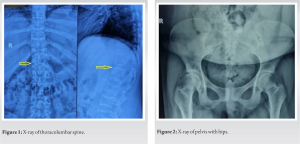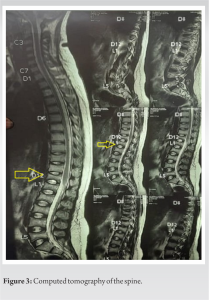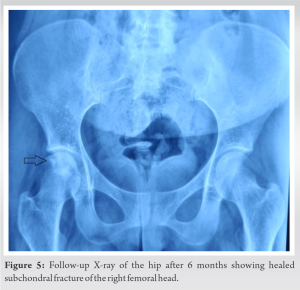Pregnancy- and lactation-associated osteoporosis is a very rare cause of back pain in pregnancy and puerperium and a high index of suspicion is needed for diagnosis.
Dr. Prannoy Paul, Department of Orthopaedics, Government Medical College, Kannur, Kerala, India. E-mail: prannoypaul@gmail.com
Introduction: Pregnancy- and lactation-associated osteoporosis (PLAO) is a rare cause of back pain during pregnancy and puerperium. We report a rare case of PLAO with subchondral fracture of the femoral head.
Case Report: A 19-year-old second gravida presented with severe back pain and an inability to ambulate due to pain in the right buttock during the puerperium. The pain started during the last trimester and was aggravated after delivery. Her radiogram showed multiple compression fractures with osteopenia in the dorsolumbar spine. A magnetic resonance imaging scan of the pelvis showed bone marrow edema with subchondral fracture involving the right femoral head. A diagnosis of PLAO was made thorough investigations and excluding other possibilities.
Conclusion: PLAO is a rare cause of back pain. Subchondral fracture of the femoral head is an extremely rare occurrence in PLAO. A high index of suspicion is needed for its diagnosis. Early diagnosis and treatment are essential to avoid complications such as vertebral fractures
Keywords: Osteoporosis, pregnancy- and lactation-associated osteoporosis, back pain in pregnancy, subchondral fracture of the femoral head.
Pregnancy- and lactation-associated osteoporosis (PLAO) was first identified by Nordin and Roper in 1955 as a rare cause of severe back pain in the postpartum period [1]. It is a rare condition. It is also a dangerous condition, as it can cause atraumatic fractures during pregnancy and puerperant conditions. It occurs in the third trimester and puerperium. The exact pathophysiology of this condition is unknown. Genetic and racial factors, physiologic changes during pregnancy, obstetrical history, preterm labor, and pregnancy-induced hypertension are some risk factors for PLAO. A proposed mechanism for PLAO is maternal bone resorption during pregnancy due to inadequate calcium stores to meet both maternal and fetal demands as well as hormone-mediated trabecular bone demineralization to supplement calcium in maternal milk [2]. We present a case of PLAO in a postpartum patient who suffered multiple atraumatic fractures of her vertebrae, clavicle, rib, and pelvic rami. Osteoporosis related to pregnancy has been described as four types in the literature, namely, idiopathic osteoporosis, postpregnancy spinal osteoporosis, transient osteoporosis of the hip, and lactation-associated osteoporosis [1]. Postpregnancy spinal osteoporosis is a rare cause of back pain in the postpartum and lactating period, which if missed and untreated may lead to complications such as vertebral fractures and deformity [3]. As back pain is a common phenomenon in pregnancy due to various causes and X-rays and bone densitometry are usually avoided during pregnancy, the incidence of this condition may be underestimated [4]. There are reports of fractures involving the vertebrae, pubic rami, clavicle, sacrum, and ribs in the literature [2]. There are no reports of fractures of the subchondral region of the femoral head in PLAO so far. Our objective is to report a case of PLAO in a 19-year-old multigravida with fracture of the subchondral region of the head of femur and multiple compression fractures of the vertebrae with a review of the literature.
A 19-year-old female presented with severe back pain and right hip pain in July 2022. She was in her puerperium. Her symptoms started as low back pain during the last trimester of pregnancy. This condition was managed with acetaminophen and rest. The pain was aggravated following delivery. There was pain in the back and right buttock and thigh. This incapacitated her from being ambulant. She found it very difficult to sit or stand. This was her second pregnancy. The antenatal period was uneventful. There was no history of trauma, infections, or any constitutional symptoms during the antenatal period or puerperant period. There was no similar history during the first pregnancy. At the time of presentation, she had a kyphotic posture. Her stature was ectomorphic. General and systemic examination was uncontributory to any diagnosis. There were no local signs of inflammation or infection of the back. Tenderness was present over the dorsolumbar spine and right hip region anteriorly and posteriorly. There was no tenderness in the sacroiliac joints. Both the active and passive straight leg raising tests were painful on the right side. There was no evidence of sensory or motor deficits in the lower limbs. Tests for sacroiliac joint and pubic diastasis were negative. We could not elicit the movements of the spine due to pain. She was not able to walk independently. Her hemogram was normal. Hemoglobin was 11 mg/dL, total WBC count was 4800, with polymorphs 52%, lymphocytes 45%, eosinophils 3%, and monocytes 2%. The erythrocyte sedimentation rate and C-reactive protein levels were within normal limits. Renal function and liver function tests were normal. Serum calcium, phosphorous, serum Vitamin D3, and PTH were normal. Serum alkaline phosphatase was 152 IU/L. Hypergammaglobulinemia without any M band was noted in the serum electrophoresis.
The radiograph of the thoracolumbar spine showed osteopenia with compression fractures in the D11, D12, and L1 vertebrae (Fig. 1). The endplate was normal with preserved intervertebral disc spaces. The radiograph of the pelvis appeared normal with no lesions in the hips or sacroiliac joints (Fig. 2). A skeletal survey was inconclusive about any pathologies.
An ultrasonographic scan of the abdomen and neck was performed to rule out intra-abdominal and thyroid and parathyroid abnormalities. However, no lesions were detected in the ultrasonographic scan. Magnetic resonance scanning of the spine showed multiple compression fractures of the dorsolumbar spine. Height reduction was predominant in the central part of the vertebral body, resulting in biconcave vertebrae. The fractures predominantly involved the D11, D12, and L1 vertebrae. There was no evidence of intervertebral disc space reduction or vertebral body lesions (Fig. 3). A magnetic resonance imaging scan of the pelvis showed bone marrow edema involving the proximal femur with subchondral fracture in the anterolateral aspect of the femoral head on the right side (Fig. 4).
From her clinical features, many possibilities, such as intervertebral disc prolapse, sacroiliitis, pubic diastasis, tuberculous/pyogenic spondylodiscitis, hyperparthyroidism, and tumors such as multiple myeloma and giant cell tumor of the vertebral body, were considered. However, investigations were not suggestive of any of these possibilities.
A diagnosis of PLAO was made by excluding all other possibilities. She was treated with Vitamin D and calcium supplements and a thoracolumbar brace. Breastfeeding was also stopped as part of her conservative management. As her family was not completed and she wishes to have another child in the future, bisphosphonates were not started due to their toxicity profile in pregnancy. By the end of 6 weeks after starting treatment, she was better with no back or buttock pain (Fig. 5). She was able to perform all routine activities without any restrictions for 6 months. She is still on follow-up without any symptoms (Fig. 6).
Postpartum osteoporosis is largely underdiagnosed. The exact incidence is unknown. The mechanisms leading to PLAO are unclear. Decreased estrogen levels and calcium deficiency during pregnancy and lactation and increased calcium demands during pregnancy and lactation are some proposed reasons for PLAO [5, 6]. A genetic predisposition to the condition is also noted by some researchers. Dunne et al. suggested a genetic predisposition by noting that mothers of patients with PLAO had a higher prevalence of fractures than mothers of controls [1]. The most common presenting symptom of postpartum osteoporosis is back pain [7]. Hence, all pregnant and lactating women presenting with severe back pain should be evaluated for this condition. There are no specific treatment guidelines available for this condition. Classically, patients are treated with calcium and Vitamin D supplements and by weaning. Some studies have noted that bisphosphonates might be effective in management [8]. However, there are reports that bisphosphonates might accumulate in the bones of the mother and may cause skeletal disorders in fetuses of subsequent pregnancies [6]. Hence, these are usually avoided in women who wish to have pregnancies in the future. Teriparatide, the human recombinant variant of the parathyroid hormone, is effective in the treatment of osteoporotic fractures. It improves bone mineral density and decreases the incidence of fractures [7]. As it does not accumulate in the skeleton, it is also safer in women who wish to have subsequent pregnancies, unlike bisphosphonates [6]. Teriparatide was found to be effective in improving bone mineral density and clinical symptoms in patients with PLAO [9]. Patients with PLAO are prone to developing recurrences in subsequent pregnancies as well. Some studies report approximately 33% recurrence [8,10]. Hence, patients need to be warned about the possibility of recurrence of the condition in subsequent pregnancies. We presented this case due to the rarity of subchondral fracture of the femoral head in PLAO. There were no previous reports of subchondral fracture of the femoral head in PLAO to date. The diagnosis was also challenging because the patient had pain in the buttock and back without any X-ray evidence of pathologies in the hip or sacroiliac joints. The laboratory investigations were negative for common causes of osteoporosis. We made the diagnosis by excluding all other possibilities.
PLAO is a rare cause of back pain. Subchondral fracture of the femoral head is an extremely rare occurrence in PLAO. A high index of suspicion is needed for its diagnosis. Early diagnosis and treatment are essential to avoid complications such as vertebral fractures.
Low back pain is very common during pregnancy and has various causes. PLAO is a very rare differential diagnosis that we should consider as a differential diagnosis. Delay in diagnosis and treatment may have serious complications.
References
- 1.Dunne F, Walters B, Marshall T, Heath DA. Pregnancy associated osteoporosis. Clin Endocrinol (Oxf) 1993;39:487-90. [Google Scholar]
- 2.Gandhi S, Rodriguez A, Baim S. MON-505 an atypical case of osteoporosis related to pregnancy and lactation. J Endocr Soc 2019;3:MON-505. [Google Scholar]
- 3.Khandelwal D, Tandon N. Overt and subclinical hypothyroidism: Who to treat and how. Drugs 2012;72:17-33. [Google Scholar]
- 4.Holmberg-Marttila D, Sievänen H, Tuimala R. Changes in bone mineral density during pregnancy and postpartum: Prospective data on five women. Osteoporos Int 1999;10:41-6. [Google Scholar]
- 5.Polat SB, Evranos B, Aydin C, Cuhaci N, Ersoy R, Cakir B. Effective treatment of severe pregnancy and lactation-related osteoporosis with teriparatide: Case report and review of the literature. Gynecol Endocrinol 2015;31:522-5. [Google Scholar]
- 6.Clemetson IA, Popp A, Lippuner K, Ballmer F, Anderson SE. Postpartum osteoporosis associated with proximal tibial stress fracture. Skeletal Radiol 2004;33:96-8. [Google Scholar]
- 7.Ofluoglu O, Ofluoglu D. A case report: Pregnancy-induced severe osteoporosis with eight vertebral fractures. Rheumatol Int 2008;29:197-201. [Google Scholar]
- 8.O’Sullivan SM, Grey AB, Singh R, Reid IR. Bisphosphonates in pregnancy and lactation-associated osteoporosis. Osteoporos Int 2006;17:1008-12. [Google Scholar]
- 9.Lampropoulou-Adamidou K, Trovas G, Stathopoulos IP, Papaioannou NA. Case report: Teriparatide treatment in a case of severe pregnancy-and lactation-associated osteoporosis. Hormones (Athens) 2012;11:495-500. [Google Scholar]
- 10.Di Gregorio S, Danilowicz K, Rubin Z, Mautalen C. Osteoporosis with vertebral fractures associated with pregnancy and lactation. Nutrition 2000;16:1052-5. [Google Scholar]
















